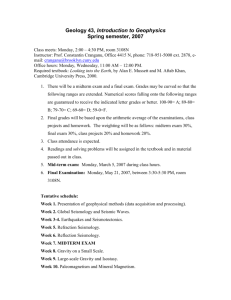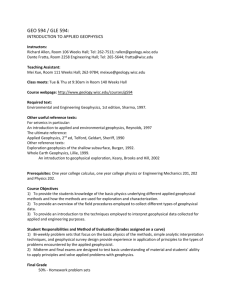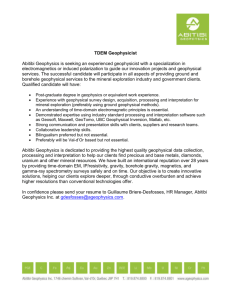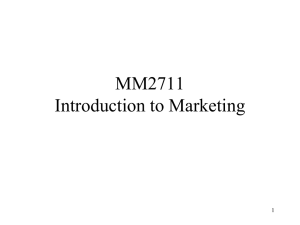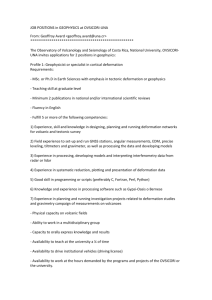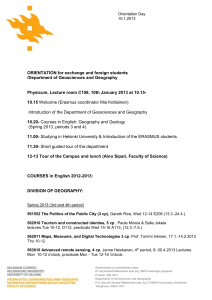No Final Exam
advertisement
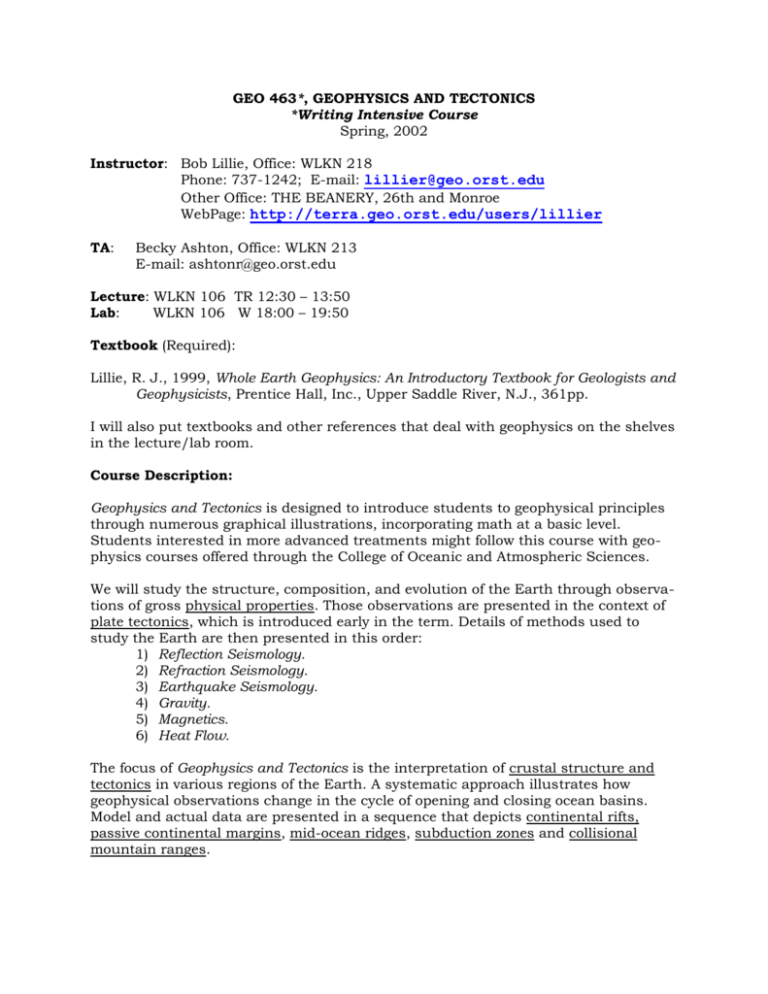
GEO 463*, GEOPHYSICS AND TECTONICS *Writing Intensive Course Spring, 2002 Instructor: Bob Lillie, Office: WLKN 218 Phone: 737-1242; E-mail: lillier@geo.orst.edu Other Office: THE BEANERY, 26th and Monroe WebPage: http://terra.geo.orst.edu/users/lillier TA: Becky Ashton, Office: WLKN 213 E-mail: ashtonr@geo.orst.edu Lecture: WLKN 106 TR 12:30 – 13:50 Lab: WLKN 106 W 18:00 – 19:50 Textbook (Required): Lillie, R. J., 1999, Whole Earth Geophysics: An Introductory Textbook for Geologists and Geophysicists, Prentice Hall, Inc., Upper Saddle River, N.J., 361pp. I will also put textbooks and other references that deal with geophysics on the shelves in the lecture/lab room. Course Description: Geophysics and Tectonics is designed to introduce students to geophysical principles through numerous graphical illustrations, incorporating math at a basic level. Students interested in more advanced treatments might follow this course with geophysics courses offered through the College of Oceanic and Atmospheric Sciences. We will study the structure, composition, and evolution of the Earth through observations of gross physical properties. Those observations are presented in the context of plate tectonics, which is introduced early in the term. Details of methods used to study the Earth are then presented in this order: 1) Reflection Seismology. 2) Refraction Seismology. 3) Earthquake Seismology. 4) Gravity. 5) Magnetics. 6) Heat Flow. The focus of Geophysics and Tectonics is the interpretation of crustal structure and tectonics in various regions of the Earth. A systematic approach illustrates how geophysical observations change in the cycle of opening and closing ocean basins. Model and actual data are presented in a sequence that depicts continental rifts, passive continental margins, mid-ocean ridges, subduction zones and collisional mountain ranges. 2 COURSE GRADE General Philosophy: C B A You understand the concepts presented in the course well enough to explain them to me. You understand the concepts well enough to explain them to anyone at The Beanery. You can use geophysical observations as constraints on geological interpretations; you can present and defend models of the crustal structure and tectonic evolution of a region based on the concepts covered in the course; you can express your ideas through writing. Value of Each Portion of the Course: Lecture Attendance 10% (0-2 absence = 10%; 2% off each other absence) Homework Problems 25% (HW1=15%; HW2=10%) Labs 30% (L1=6%; L2=6%; L3=6%; L4=6%; L5=6%) Written Papers 35% (P1=5%; P2=8%; P3=10%; P4=12%) Final Course Grades: 100% - 93% A 76.9% - 73% C 92.9% - 90% A72.9% - 70% C89.9% - 87% B+ 69.9% - 67% D+ 86.9% - 83% B 66.9% - 63% D 82.9% - 80% B62.9% - 60% D79.9% - 77% C+ 59.9% - 0% F Attendance (10% of course grade): You must come to every lecture. Reasons: Practical examples are presented in the lectures; the small class size is ideal for interaction; you're supposed to be grown up! Homework Problems (25% of Final Grade): Homework sets will be mostly quantitative, giving you a feel for theoretical as well as applied problems. Try to understand for yourself what's going on, but don't hesitate to consult with me or with other students. Please show intermediate steps used in coming to an answer. In fact, an answer alone will not do - I am interested in the thought processes involved in getting there! Labs (30% of Final Grade): Lab 1. Interpret seismic reflection profile. Lab 2. Interpret seismic refraction profile. Lab 3. Interpret earthquake seismogram. Lab 4. Construct a plate tectonic-scale cross section and plot and interpret geophysical observations. Lab 5. Model gravity profiles interactively on PC’s. Exercises will be started during the scheduled lab time. Completed labs are due at a later, specified time. For some labs you will work individually, for others in groups of two to four. It’s okay to work together to complete any of the exercises; don't be afraid to consult with the TA or me, too! 3 Research Paper (35% of Final Grade) Each student will research and write a paper on the crustal structure and tectonic evolution of a selected region. Appendix A of the textbook outlines the steps involved. Due Dates (No Late Papers Accepted): Papers are due at the beginning of class on dates stated. Each paper is worth a portion of the final grade. I will not read papers turned in late; you simply get no credit for that paper. Paper 1: Thursday, April 25 (5%) Paper 2: Thursday, May 9 (8%) Paper 3: Thursday, May 23 (10%) Paper 4: Thursday, June 6 (12%) TOTAL: 35% of course grade Figures: - You may include photocopies of figures from papers. - May be on additional pages at the end of your paper. - Include the original figure caption with each figure. - Give your own, brief caption and cite the reference. 1. Write the reference for the figure (for example, "Jones et al., 1983") directly on the figure. 2. In addition to the original caption for the figure, type out your own brief caption, including: a) an explanation of what the figure shows ("Tectonic map of the East African Rift System, showing location of refraction lines recorded during the KRISP experiments." and b) the figure's source ("from Jones et al., 1983."). References Cited List: Internet sources may be up to only 25% of your References Cited list. At least 75% of your references must be from printed, refereed journals. To cite references, use the format of one of the following journals: Geological Society of America Bulletin American Association of Petroleum Geologists Bulletin Geology Journal of Geophysical Research Proper Presentation and Citation of Ideas: The writing must be your own. When you express ideas from the literature, cite the source of the ideas. 1) Paraphrase ideas from a paper in your own writing and cite the paper. 2) If you find it better to quote a phrase, sentence, or paragraph verbatim, include the material in quotation marks and cite the source. Plagiarism is defined on p. 145 of the OSU, 1992-93 Schedule of Classes as "intentionally or knowingly representing the words or ideas of another person's as one's own." Please be careful in preparing your paper; I consider academic honesty a serious matter. See me if you have questions about how to properly present and cite other people's writing and ideas. 4 GEO 463/563, Spring, 2002 Tentative Schedule Date Lecture/Lab Turn in by this Date -------------------------------------------------------------------------------------------------------Tue Apr 2 Geophysical Methods as Constraints on Geology (Chap. 1) Wed Apr 3 Lab: Using Library Resources for Geologic Research Thu Apr 4 Plate Tectonics (Chap. 2) -------------------------------------------------------------------------------------------------------Tue Apr 9 Seismic Waves (Chap. 3) Topic for Paper Wed Apr 10 Lab 1: Reflection Profile Interpretation Thu Apr 11 Seismic Reflection Interpretation (p. 100-103 + Chap. 6) -------------------------------------------------------------------------------------------------------Tue Apr 16 Seismic Reflection Interpretation (cont.) Wed Apr 17 Lab 1: (cont.) Thu Apr 18 Geophysics Research Paper on Hawaii Lab 1 -------------------------------------------------------------------------------------------------------Tue Apr 23 Refraction Seismology (Chap. 4) Wed Apr 24 Lab 2: Refraction Profile Interpretation Thu Apr 25 Refraction Seismology (cont.) Paper 1 -------------------------------------------------------------------------------------------------------Tue Apr 30 Earthquake Seismology (Chap. 7) Wed May 1 Lab 3: Earthquake Seismogram Interp. Lab 2 Thu May 2 Earthquake Seismology (cont.) HW1 -------------------------------------------------------------------------------------------------------Tue May 7 Earthquake Seismology (cont.) Lab 3 Wed May 8 Lab 4: Plate Tectonic Cross Section Thu May 9 Gravity (Chap. 8) Paper 2 -------------------------------------------------------------------------------------------------------Tue May 14 No Class (GSA Meeting) Wed May 15 Lab 4: (cont.) Thu May 16 Gravity (cont.) Lab 4 -------------------------------------------------------------------------------------------------------Tue May 21 Gravity (cont.) Wed May 22 Lab 5: Gravity Modelling Thu May 23 Magnetics (Chap. 9) Paper 3 -------------------------------------------------------------------------------------------------------Tue May 28 Magnetics (cont.) Wed May 29 Lab 5: (cont.) Thu May 30 Heat Flow (Chap. 10) Lab 5 -------------------------------------------------------------------------------------------------------Tue Jun 4 Geophysics and Tectonics of the Pacific NW HW 2 Wed Jun 5 No Lab Thu Jun 6 Geophysics and Tectonics of the Pacific NW Paper 4 -------------------------------------------------------------------------------------------------------No Final Exam
